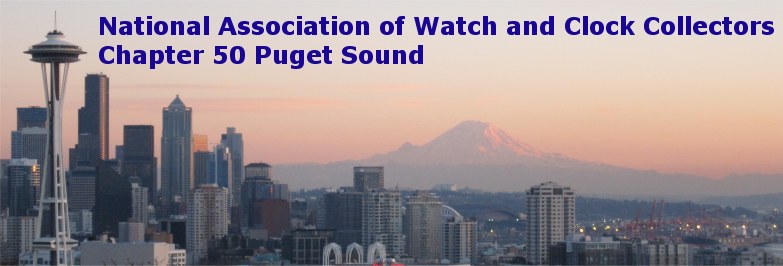SEATTLE’S FIRST WATCHMAKERS 1869 -1889
Bringing Time to the Public in the Pacific Northwest
By
Paul Middents FNAWCC
Standard time calibrated to the Greenwich meridian reached the nation
and the Pacific Northwest in 1884, about the same time a fifteen year
old German Jewish immigrant named Joseph Mayer arrived in Seattle and
took up the trade of watchmaker and jeweler. Eventually he became a
true clock maker specializing in street and tower clocks. His role in
spreading public time around the West over the next 50 years sparked my
interest in considering Seattle’s place in the jewelry and watchmaking
trade and its evolution while he was launching his career.
Fig.
1. This 1869 image
of Seattle shows a watchmaker’s sign on Commercial
St.—probably the first watchmaker in town. The sign was not a
functional timekeeper. (1) Seattle’s first watchmaker. East side of
Commercial St. between Main and Washington. (2) Masonic Hall on Front
St. This was home to W.G. Jamieson and his brother, J.L. Jamieson for a
few months in early 1878. From a panoramic Washington State Historical
Society photo (1991.1) of Seattle 1869 by Robinson.
First Watchmakers
A photo from 1865 of Commercial St. shows the buildings pictured in
Fig. 1 but the watchmaker’s sign is absent. , The territorial
capitol, Olympia, had one jeweler in 1861; Julien Guyot, a 35 year old
Swiss immigrant. A Pacific Coast Directory for 1867
lists three watchmakers in the Washington Territory; two east of the
Cascades in Walla Walla, then Washington Territory’s largest town
(population about 1400), and one in Port Townsend on the Olympic
Peninsula. Port Townsend was a contender for the territory’s
principal seaport and railway terminus. Seattle was a frontier village
with a population of 1107 in 1870, less than 20 years after its first
settlement by the Denny Party. By contrast, San Francisco, population
57,000, had 106 watchmakers and jewelers in 1860.
William G. Jamieson, a 25 year old immigrant from Victoria, Vancouver
Island, opened a jewelry business in September 1870. Fig. 2. An 1871
Pacific Coast Business Directory lists George W. Parker and Leonard P.
Smith as watchmakers and jewelers in Seattle. No addresses are
given. Smith, age 56, was born in Maine. He, together with his
wife and his 21 year son probably arrived before 1870 as did Parker.
Either
Fig. 2. (1) Jamieson’s first advertisement appearing in an 1870 issue
of the Olympia’s Washington Standard. (2), (3), (4) Advertisements from
the 1872 directory.
Parker or Smith could have occupied the location pictured above
in 1869. See also the 1878 map
Putting Seattle on the Map
Seattle literally was placed on the map in 1871 through the telegraphic
determination of the town’s longitude. The routine dissemination of
telegraphic standard time signals would not become available for almost
20 years. Each community ordered business according to local time which
was established by observing local noon which can be estimated by eye
or more precisely by an optical instrument such as a sextant or
transit. The arrival of railroads, scheduled steamer and ferry service
and telegraphic communication sparked public awareness of time and
brought the “public time era” to the Northwest. Men were carrying
watches in increasing numbers and the commercial life of cities and
towns was being conducted in accordance with the standard time for a
whole region. Jewelers were the first to provide reliable and accurate
local or standard time to the inhabitants of these towns.
Watchmakers could estimate local time but with an accurate longitude
they could make a precise determination of local time or time at any
other reference longitude through star observations. This was of
real significance to ship’s navigators in the harbor who were checking
their chronometers; to the watchmakers who were repairing and rating
chronometers; to railroad men and ferry boat men who were trying to
operate trains and ferries to a schedule. The watchmakers disseminated
time by regulators (precision pendulum clocks) or chronometers
displayed in their shops. They sold pocket watches emphasizing their
accurate timekeeping.
In August 1871 the U.S. Coast and Geodetic Survey established an
astronomical station consisting of a brick pier and temporary shelter
near Jackson and Front Streets about where Occidental Park is
now. The station was equipped with a meridian transit instrument
mounted on the brick pier. This was used for determining the latitude,
the local time and checking the rate of a chronometer via star
observations. Western Union provided a temporary telegraph connection
so time signals could be exchanged with a similar station on Washington
Square in San Francisco. The longitude of San Francisco had already
been determined by extensive astronomical observations. The longitude
difference between Seattle and San Francisco was determined by
exchanging telegraphic local time signals over an extended period.
Successful star observations and time signal exchanges were made on 12
nights. Forest fires throughout Oregon and the Washington
Territory caused frequent loss of telegraph connections. The San
Francisco observer in charge of the operation observed 602 transits of
81 stars on 38 nights.
Someone might have asked what the full extent of the country was
because the next Seattle longitude measurement determined the
difference between Seattle and Tatoosh Island. This was more likely
motivated by the need for an accurate position of the Cape Flattery
Lighthouse. The 1871 Jackson St. station had succumbed to urban
development by 1886. So in May 1886 USC&GS Assistant J.J. Gilbert
set up a new station on the grounds of the Washington Territorial
University consisting of a “suitable building and instrument pier” from
which the longitude difference of Tatoosh Island was determined.
Omaha marked the western extent of the national longitude net in 1884.
The net reached the far west and Washington Territory first in 1887
when Salt Lake City was connected to Walla Walla. In the summer of
1888, Edwin Smith, one of the Survey’s most noted Assistants found the
Seattle station established by Gilbert two years earlier, in good
condition. He described it as “on the grounds of the university at the
break of the hill sloping down to the art building”. A series of
exchanges that summer tied Seattle to the national longitude net via
Walla Walla and Portland. Thus the Washington Territorial
University (now the site of the Olympic Hotel) established the
longitude reference for the triangulation of western Washington
including our complex coastline and vital waterways.
Competing and Moving Around
An 1872 Puget Sound directory lists Smith on Mill St. next to the
Intelligencer building. Parker moved to Olympia by 1872. Sometime
after 1872 Smith moved his business out of Seattle for a short time but
we don’t know where. An 1876 newspaper ad says he moved back to
Seattle. His business now, L.P. Smith and Son, was located on Front St.
in Reinig’s Building opposite the brewery. Fig. 5. The son,
Alfred A. Smith, now his father’s partner, and his wife were living
with his parents in 1880. The Smiths moved a few yards south to
Sullivan’s Block on Front St. sometime before 1879 where they remained
in business until 1887. Figs. 6 and Fig. 9.
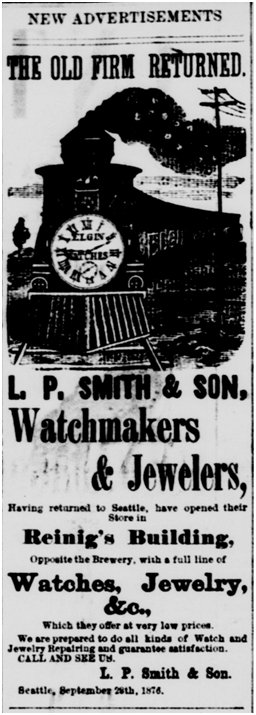 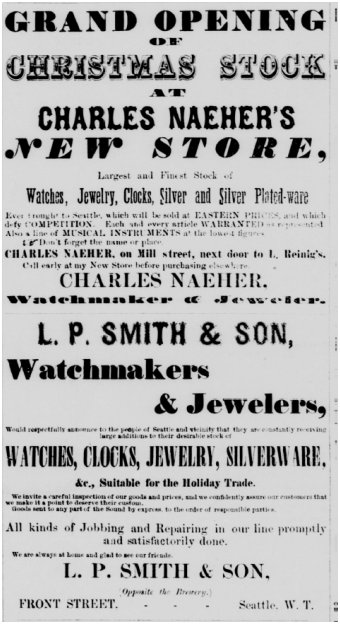
Fig. 3. Above: Seattle Daily Intelligencer Dec. 11, 1876
Left: Daily Intelligencer Sep. 29, 1876
William G. Jamieson and Charles Naeher (Naher) were both listed as
jewelers in the same 1872 directory on Commercial St . Figs. 2, Fig. 3,
Fig. 4. Jamieson immediately launched an aggressive advertising
campaign. Naeher, a 43 year old German immigrant, left a jewelry
business in St. Paul, MN. Both his sons worked for him, one as a clerk
and the other a watchmaker. Naeher moved to Mill next door to Rienig’s
Bakery in 1876. (Mill near Front), and into the Yesler Leary Building
on Mill St. in 1883. He remained in business until his death in about
1890. His elder son became a vice president of

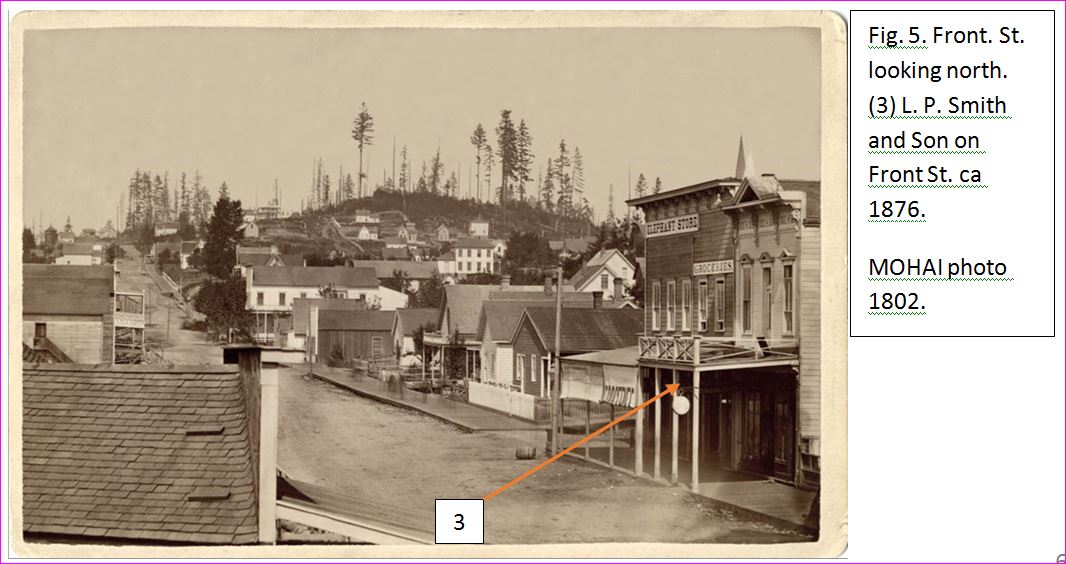
Schwabachers, Seattle’s
first and for many years, premier department store and hardware
wholesaler.
Seattle’s First Public Clock
Based on the size and number of ads (1876-1879), W.G. Jamieson tried to
be the largest and most competitive jeweler. In 1877 he was
occupying two brick fireproof stores on the corner of Commercial and
Mill Streets with his “Jewelry, Music and Art Emporium” and claiming to
be largest business of its kind north of San Francisco. He advertised a
wide variety of goods in addition to jewelry, silverware, watches and
clocks. These included books, stationary, musical instruments and agent
for the Singer Sewing Machine Company. October 1877 found him posting
notices pleading for people to pay their bills. In January 1878 he
announced a move to the Masonic Hall on Front St. Fig. 1. In February
of 1878 the Intelligencer reported he had installed a “transparent
magic clock” in his window with a reflector behind it and between them
a calcium light. “It is the next best thing to a town clock that could
have been devised.” Jamieson went into receivership April 18, 1878 in
spite of his innovative public timepiece.
Time by Telegraph
William’s younger brother, John L. Jamieson showed up on the pages of
the Daily Intelligencer in June of 1876 advertising as a Book,
Stationary and Tobacco store next to Schwabachers on Commercial St.
November 1876 ads place him in Coleman’s brick building, Mill St. Fig.
7 An 1876-78 Pacific Coast Directory lists him as a jeweler on
Mill St. January 1878 found him sharing quarters with his brother in
the Masonic Hall on Front St. In May 1878 he ran a very
interesting ad as a watchmaker and jeweler in Wentzler’s new building
on Front St. His specialty is in watch and jewelry repair. He states
that “The true time is received daily by telegraph from the U.S. Signal
Station and kept by a first class chronometer, enabling those having
fine watches to have them accurately rated.” This is the first
indication I have of a jeweler using time by telegraph in Seattle and
making it available to the public. This service was short lived. His
last ads appeared in September 1878
U.S. Signal Stations were established as meteorological observatories.
The Army’s Chief Signal Officer reported that a station had been
established in Olympia, W.T. in 1878. In 1870, the Signal Corps
established a congressionally mandated national weather service.
This included a network of weather observatories called U.S. Signal
Stations. Some of the more famous included ones on top of Mt.
Washington in New Hampshire and Pikes Peak, Colorado. By 1879 the
Signal Corps had constructed, and was maintaining and operating, some
4,000 miles of telegraph lines connecting the country's western
frontier. The Signal Stations reported their results by this
system. The Signal Service master clock telegraphed Naval Observatory
Washington time signals to the Signal Stations, coordinating the
observations. Jamieson’s is the first known example of these
signals being distributed to private users. Note that this predates by
several years the adoption of standard time zones or the routine
distribution of time signals by Western Union.
John Jamieson’s last ad in the Intelligencer ran Sep. 27, 1878. An 1879
directory lists him as a jeweler on Cherry between Front and
Second. The 1880 census finds both James and his brother, William
working as watchmakers in Walla Walla, probably for Zebulon K. Straight
Walla Wall’s most prominent watchmaker.
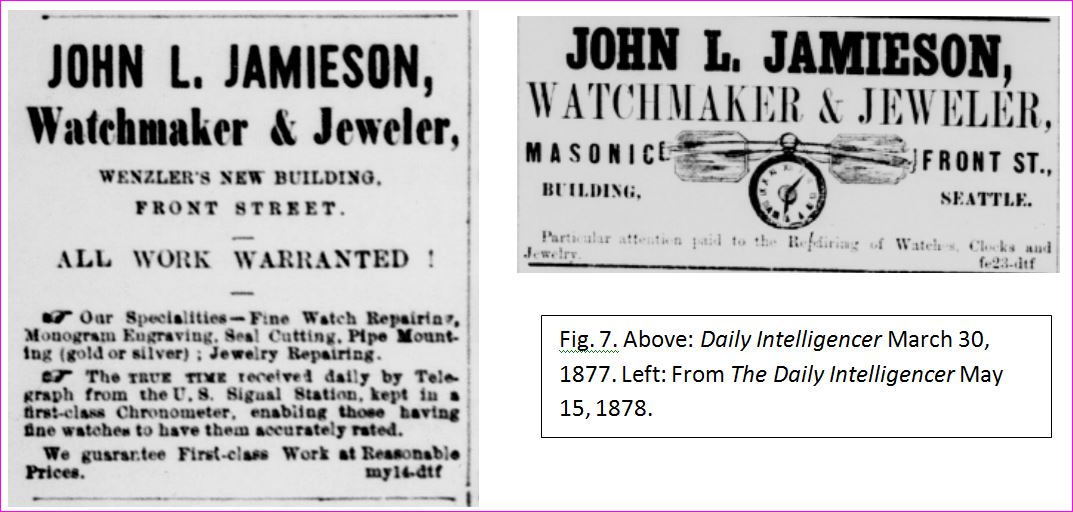
Jewelers from 1882-1889
Five jewelers were listed in 1876. Smith, Naeher and the Jamieson
brothers had been joined by William Hanson specializing in repair only.
Hanson disappeared within a year or two. The Jamieson’s had both moved
on by 1879. Seven jewelers were in business by 1882 and nine in 1884.
Smith and Naeher also advertised as wholesale jewelers for the first
time in 1884.
William H. Finck arrived in 1882 and opened a jewelry store on
Commercial St. opposite the New England Hotel. Finck was a 24 year old
Canadian immigrant, son of a German father and Canadian mother. He was
working as a jeweler in Oroville, California in 1880. Finck established
a successful and long lived business. He would eventually install a
street clock which stood in front of his store until he retired in 1913.
H.J. Requa, a 25 year old native of Wisconsin showed up first as a
jeweler in 1882. He was in partnership with A.E. Giering in 1884. By
1888 they went their separate ways; Giering in partnership with Charles
O’Donnell; Requa in several locations. Fig. 11.
The Yesler-Leary block, Seattle’s most substantial pre fire commercial
building, opened in 1883. It occupied the southwest corner of Mill and
Front St. Charles Naeher moved into the Mill St. side. Albert
Hansen opened his jewelry store in 1884 on Front St. in the Yesler
Leary block. Fig. 12. Albert was born (1857) and raised in
Denmark of a German father and Danish mother. He and his two older
brothers, Theodore and Rudolf, immigrated in 1879. All three were
jewelers. They went first to California where the oldest brother,
Theodore married and started a family. Albert never
married. Hansen would install one of Seattle’s first
street clocks in 1890. He and Theodore opened stores in Spokane and
Tacoma about the same time where they also installed identical Seth
Thomas clocks. These stores did not survive the financial panic of
1893. They consolidated their business in Seattle which then grew into
one of Seattle’s largest and most well respected jewelry stores,
continuing in business until 1930.
Time from the sun and stars
Gerhard Beninghausen, a German immigrant, worked for Kimball and Son
upon his arrival in 1883 and established his own business in 1884.
Beninghausen’s first location was on the west side of Commercial
between Washington and Mill. Fig. 10.
Beninghausen was a serious watchmaker. He is the first Seattle
watchmaker to repair and rate chronometers, an important service in a
town that wanted to be a major seaport. He took daily
observations of the sun and stars for local time. Telegraphic time was
not routinely available in Seattle until about 1890. This underlines
J.L. Jamieson’s pioneering telegraphic efforts in 1878. Fig. 8
Beninghausen had a very successful jewelry business which he sold in
1905. His store front was distinguished by Seattle’s only street time
ball. A few years later he reopened as a watch and chronometer
repairer and continued until his death in 1922.
Fig. 8. From Seattle Post
Intelligencer Feb 21, 1887
Jewish Jewelers in Seattle
Joseph Mayer arrived in 1883 at age 15. He would eventually found
a wholesale jewelry and jewelry manufacturing company that would become
the largest on the West Coast. His 1883 arrival in New York from
Germany was just in time to take advantage of the Northern Pacific
railroad’s first connection to the Northwest, from St Paul, Minnesota
to Portland and Tacoma. This event shortened a journey which might have
taken weeks or months into one of a week or so. Mayer probably
completed the journey either on a steamer from Tacoma or on the Puget
Sound Shore Railroad.
Seattle was a brawling frontier village that had just passed Wall Walla
to become the territory’s largest town. It was well on its way to
becoming a city of over 12,000 people engaged in lumbering, fishing,
shipping and wholesale trade. Seattle saw 1000 new homes built in 1884.
The city was riven with ethnic violence by the anti-Chinese riots in
1885-86. The territorial governor placed Seattle under martial law for
a period. Lynching was not unheard of during this relatively lawless
period.
Joseph joined a Jewish community of 100 or so. Many, like
himself, were German speaking from central Europe, some of whom were
very successful entrepreneurs. These included Bailey Gatzert, manager
of Schwabacher Brothers general wholesale and retail store. He became
mayor of Seattle in 1875.
Henry E. Levy, a 35 year old New Zealand immigrant, established a store
on Commercial St in 1876. He called it “The Seattle Bazaar”
specializing in glassware and pottery. An 1888 gazetteer lists
him also as a jeweler. There is no indication that he was a watchmaker.
Morris Abram, was a pawnbroker on Mill St. in 1882. Jacob Levy and his
family make their first appearance in 1888 as a tailor and pawnbroker
at 206 Commercial. His 19 year old son, George F. Levy, was working as
a watchmaker for Frisch Brothers Jewelers (Norwegian immigrants) in
1888 and then the following year for his father. George was apparently
in delicate health and attempted suicide in 1891. He survived and
worked periodically for Frisch Brothers and independently over the next
several years.
None of these seem very likely as employers for Joseph Mayer who would
have needed to continue his apprenticeship as a watchmaker. Charles
Naeher and Gerhard Beninghausen were the only native German speakers
with their own businesses that might have employed Mayer. Simon
Rumpf, a German Jew, arrived in 1886 and worked a short time for
Beninghausen. Rumpf would eventually become Mayer’s ill-fated partner
in his first independent enterprise as a pawnbroker and wholesale
jeweler. Naeher was nearing retirement so Beninghausen seems the most
likely to have taken Mayer in.
Joseph was joined by his younger brother, Albert, age 15, who arrived
in Seattle July 1, 1888. The 1889 directory lists 12 watchmakers
and jewelers and four pawnbrokers. Neither Joseph nor Albert appears in
this directory.
Nathan Phillips, an orthodox Jew, age 23 arrived in Seattle in 1888. He
is the first eastern European Jewish watchmaker that I can document in
Seattle. An 1890 directory lists him as a “Peddler”. In 1892 he is
listed as a jeweler and in 1893 he is listed under Clocks, Watches and
Jewelry at 207 Washington, just across the street from Rumpf and
Mayer’s Uncle Harris Pawnshop. (204 Washington). 1894 and ’95
directories list him as Boston Loan Office at 214 Washington.
Phillips was apparently in the habit of taking a selection of watches
and jewelry to the mining camps east of Seattle. June 29, 1896 found
him on such a trip, staying at the Monte Cristo Hotel in Monte Cristo
Washington. Monte Cristo, now a ghost town in eastern Snohomish County,
was the first silver mining center on the western slope of the
Cascades. By 1893 there were over 200 claims. John D. Rockefeller had
bought up a controlling interest in most. The Monte Cristo Hotel and
associated brothel was owned by Frederick Trump, the Donald’s
grandfather. A rapscallion named David Leroy approached Phillips at the
hotel with a watch to repair and lured him to the outskirts of town
with the promise to connect him up to someone who wanted to buy a
watch.
As they approached Leroy’s home, the thief demanded Phillips’ satchel
containing $1000 worth of watches and jewelry. Before Nathan could
comply, Leroy drew his gun, fired, knocking Phillips to the ground.
Leroy shot him again, this time through the back. Witnesses later
stated they saw Leroy and his brother heading for the high timber
carrying a rifle and a brown satchel. Phillips, in very bad shape, was
taken back to the hotel where he was given some rudimentary first aid
for his injuries. The following day his brother and two doctors arrived
by train from Seattle. Phillips was treated and returned to Seattle
where he recovered at Providence Hospital.
The hotel landlord retrieved Phillips blood stained vest where he found
the watch given to Phillips by Leroy. It had stopped the first bullet,
saving Phillips life. The newspaper account described Phillips as
standing high among the merchants of Seattle with a most excellent
reputation among the Jewish citizens. They noted he had been in the
loan business for the past four years.
Phillips moved his business to 106 Occidental in 1898. He married
Johanna Brooks, the daughter of the first rabbi of the Bikur Cholem
congregation, that same year. Bikur Cholem, the first orthodox
synagogue in Seattle, was dedicated in 1898.
Nathan Phillips passed away at age 38, June 11, 1903. He left a family.
He had been in poor health for some time probably aggravated by his
near death experience in Monte Cristo. His business continued at 821
1st Ave. A number of pocket watches survive with his name on the dials
and movements.
City directories for 1890 and 1891 show Joseph, now 21, working as a
watchmaker for Augustus Franklin, a pawnbroker, at 204 Washington St.,
just around the corner from Albert at 207 3rd Ave. The directory
entries for both imply that they were living at the same address they
worked. Franklin appears only in the 1890 and 1891 directories and
disappears the next year.
Albert was working for “M. W. or M. M. Fredrick” at 207 S. 3rd Ave,
rooming at the same address. Morris M. Fredrick is listed as a jeweler
rooming at that address. Morris, also a German Jew, was born in 1837,
immigrated in 1853 and by 1880 was living in Virginia City, Nevada,
listed as a jeweler. He married Anna in 1859 and they had a son, Marcus
W. born in 1863. Morris and his family moved on to San Francisco
where he became a manager for Will and Finck, well known manufacturing
cutlers. The 1891 directory lists Marcus W. Fredrick (Fredrick and Co.)
at 207 3rd, still boarding at the same address. Morris was probably
dividing his time between San Francisco and Seattle. He was still
listed as a Vice President of Will and Finck in 1896. A 1909
Seattle Times social page report of his 50th wedding anniversary refers
to him as a pioneering Seattle jeweler who arrived in the city in
1889. His son, Marcus may have managed Fredrick and
Co. for the first few years, eventually returning to San Francisco
where he was listed in 1909 as an “oculist and aurist”. This is
consistent with the family memories of Janet Levy, Albert Mayer’s
granddaughter, recorded in 1972. Her grandmother, Leah, used to talk
about her grandfather learning watchmaking from Mr. Fredrick. She
stated that her grandfather became a fine watchmaker. Morris
Fredrick was the first really successful Jewish jeweler in Seattle. He
moved to 2nd Ave. in 1894, taking over a store with a Howard street
clock which had come to the city the year before.
Joseph and Albert Mayer are among the first Jewish watchmakers to
arrive in Seattle that I can identify. Both probably received some
apprentice training in Germany before emigrating and then completing
their apprenticeships in Seattle. They went on to found a great jewelry
manufacturing and wholesale house in 1897.
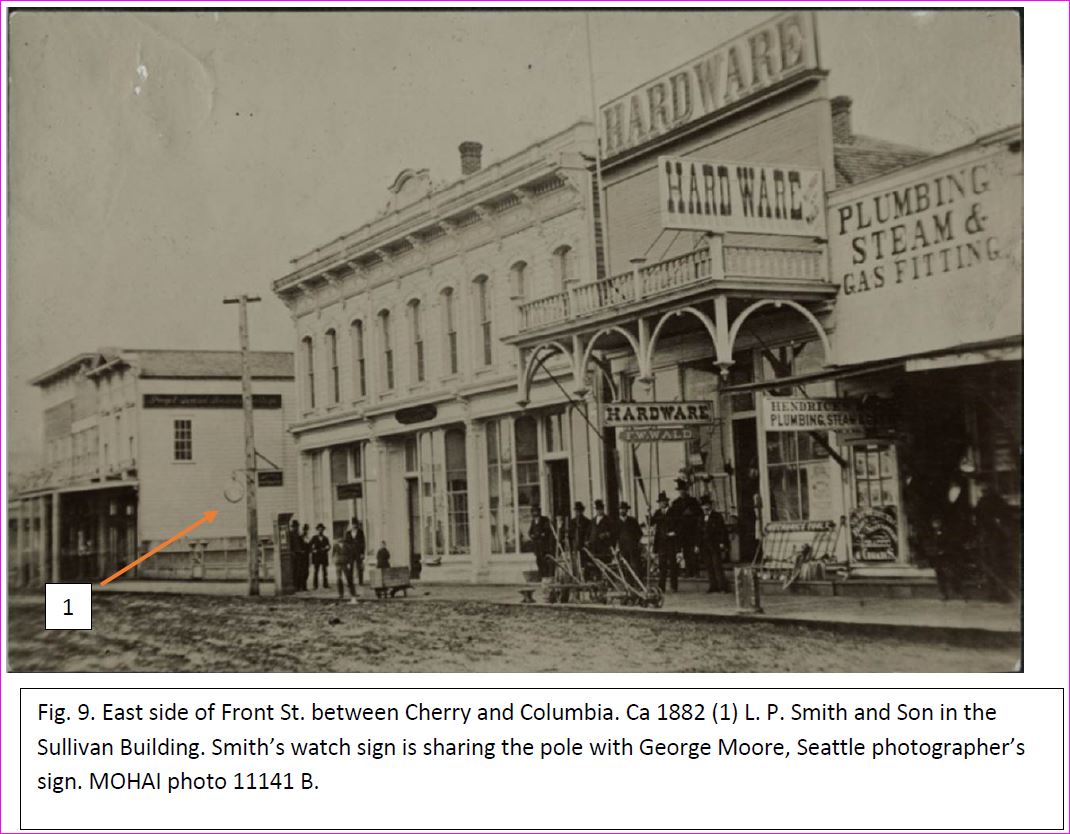
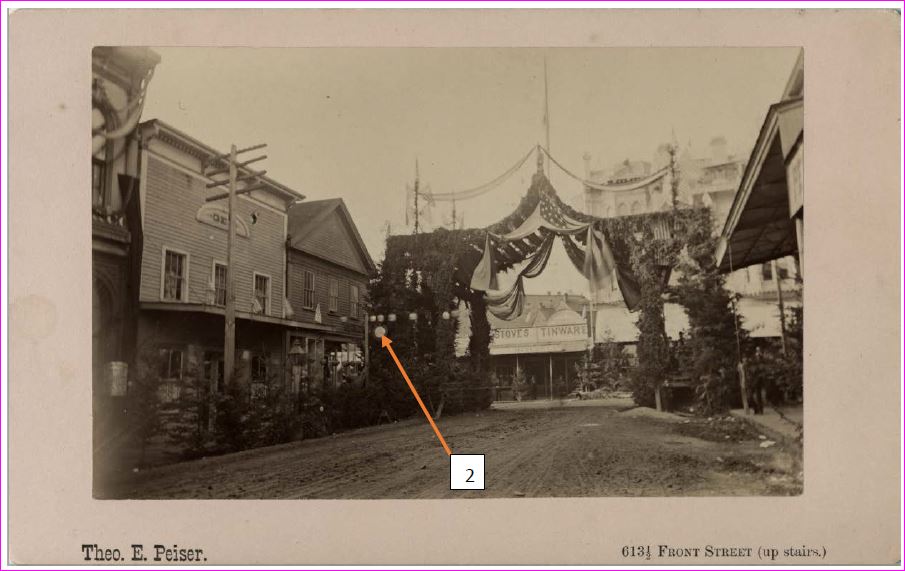
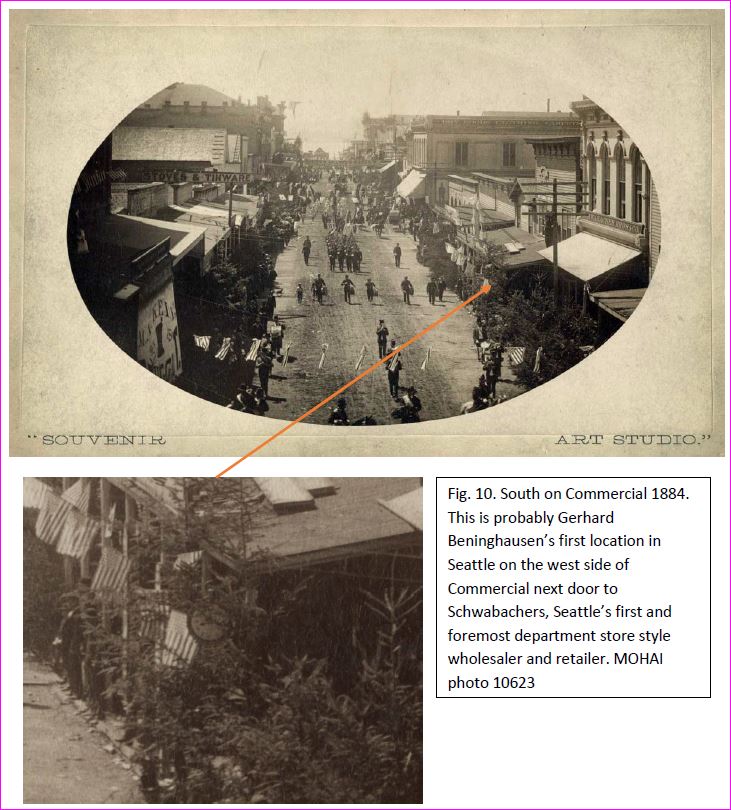
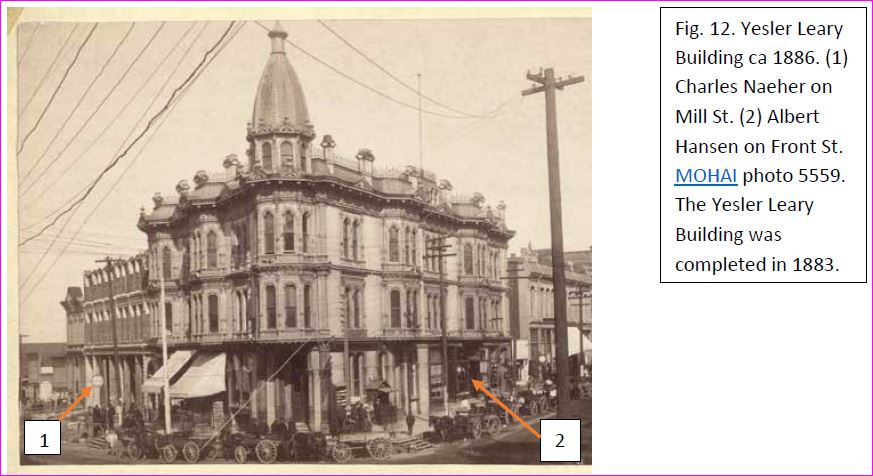 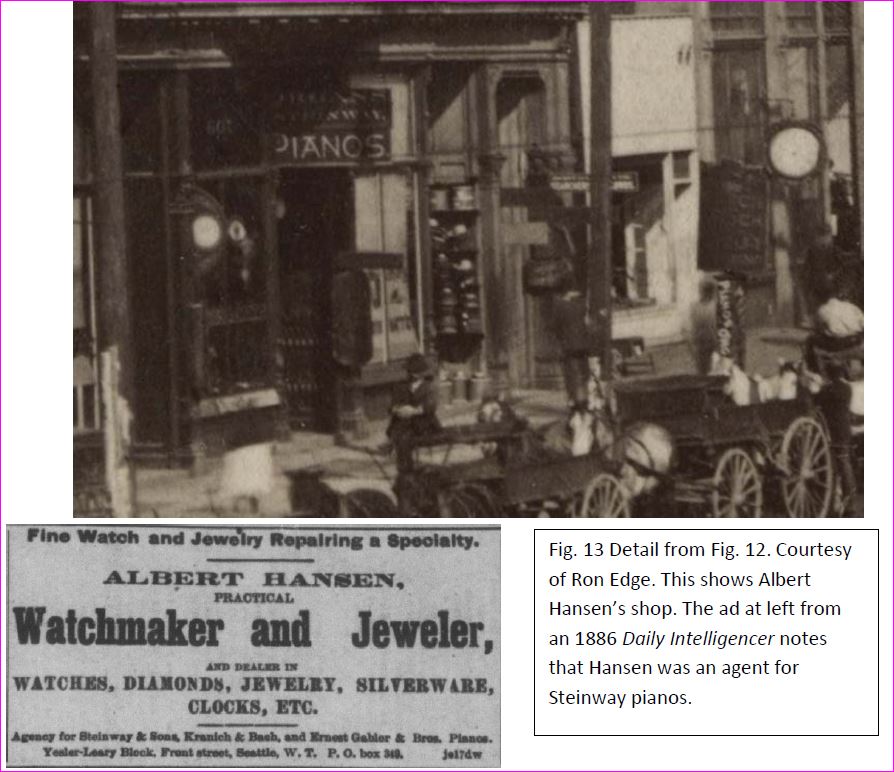
The First Tower Clock in Seattle
Only one actual public clock greeted Joseph Mayer upon his arrival in
Seattle. Seattle’s Central School, the largest public school in the
Washington territory, was completed in 1883. It sported a four
dial tower clock of unknown make. There is no record of it in E. Howard
Clock Co., Boston or Seth Thomas, Thomaston, CT records. These two
companies supplied the vast majority of public clocks across the
country after 1870. The school burned in 1888 and the building which
replaced it had a tower with dial like openings but no clock. It would
be almost twenty years before Seattle saw its next tower clock. Fig.
14.
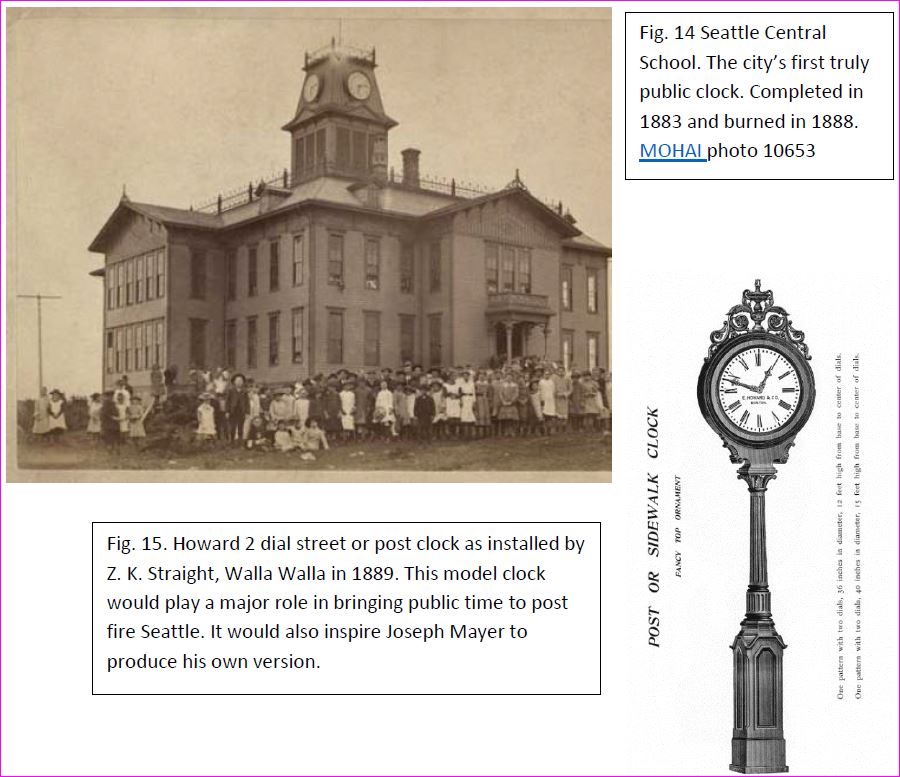
Distributing Standard Time in Walla Walla
The earliest standard public time in the Washington Territory was
probably supplied to the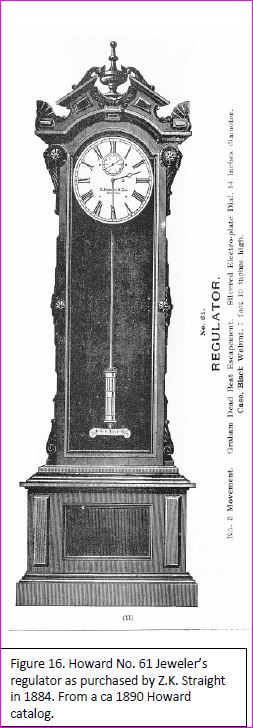 citizens of Walla Walla by
Zebulon Kenyon
Straight, one of the most prominent jewelers in the Territory.
Straight opened his business in 1870 after training as a watchmaker in
Minneapolis. On April 16, 1884 he ordered a top of the line clock from
Nordman Brothers, a San Francisco agent for the E. Howard Clock
Co. This was shipped from Boston, completing its journey via the
Northern Pacific Railroad. The line had just been completed the
previous year, connecting St. Paul, Minnesota to the Washington
Territory and Portland. The clock was a Model No. 61 regulator,
standing over seven feet tall in an imposing carved black walnut case
Fig. 16. The movement was fitted with jeweled pallets and a temperature
compensated, mercury pendulum. The glass door proudly proclaimed “City
and Railroad Time”. An 1889 catalog lists this clock for $350
plus shipping. . Routine telegraphic time signals from the Naval
Observatory would not be available for several more years. Straight
must have used a small telescopic transit instrument and calculated
local time based on sun and star sights. He would then correct these
observations to the meridian for the Pacific Time Zone. citizens of Walla Walla by
Zebulon Kenyon
Straight, one of the most prominent jewelers in the Territory.
Straight opened his business in 1870 after training as a watchmaker in
Minneapolis. On April 16, 1884 he ordered a top of the line clock from
Nordman Brothers, a San Francisco agent for the E. Howard Clock
Co. This was shipped from Boston, completing its journey via the
Northern Pacific Railroad. The line had just been completed the
previous year, connecting St. Paul, Minnesota to the Washington
Territory and Portland. The clock was a Model No. 61 regulator,
standing over seven feet tall in an imposing carved black walnut case
Fig. 16. The movement was fitted with jeweled pallets and a temperature
compensated, mercury pendulum. The glass door proudly proclaimed “City
and Railroad Time”. An 1889 catalog lists this clock for $350
plus shipping. . Routine telegraphic time signals from the Naval
Observatory would not be available for several more years. Straight
must have used a small telescopic transit instrument and calculated
local time based on sun and star sights. He would then correct these
observations to the meridian for the Pacific Time Zone.
Straight was the first in the Washington Territory to add a two dial
post or street clock to his business on Walla Walla’s Main Street. Fig.
15. He chose one from Seth Thomas’ principal rival, E. Howard
Clock Co. Boston. Ordered May 18, 1889, the first street clock in
Washington cost $300 delivered from the Chicago office of E. Howard via
the Northern Pacific. Fig. 14. Later that same year
Washington became a state with Zebulon K. Straight as a member of the
first state legislature
Conclusion
Seattle’s first jewelers are an interesting mix of mature, experienced
and probably well capitalized men and young entrepreneurs. Smith and
Naeher both were in business with their sons. They survived the
national financial crisis of the 1870’s and continued until retirement
in the late 1880’s. Smith’s son continued in business for a short time
and then disappeared. Naeher’s oldest son became a vice president of
Schwabachers. The Jamieson brothers never seemed to be in business
together except for a short period when they shared premises in the
Masonic Hall. William used extravagant advertising and apparently
stocked a wide variety of goods including sewing machines and musical
instruments. He was probably too generous in extending credit and went
into receivership. That he and his brother were competent watchmakers
would be attested to by their eventual employment with Zebulon K
Straight, Walla Walla’s leading jeweler.
The second wave of jewelers arriving in the 1880’s included several who
would survive the great fire, June 6, 1889. The early history of
Seattle is starkly divided by this event. By the morning of June
7, the fire had burned 25 city blocks, including the entire business
district, four of the city's wharves, and its railroad terminals.
1889 found 12 jewelers in business. Seven remained in business
following the fire. Among these were William Finck, Albert Hansen,
Gerhard Beninghausen and W.W. Houghton, all of whom grew into
substantial businesses lasting well into the 20th century. They also
all eventually had street clocks obtained from Joseph Mayer. The rapid
recovery and complete rebuilding of Seattle’s commercial center in
durable brick and stone attracted craftsman and entrepreneurs. The
number of watchmakers and jewelers listed doubled from 16 in 1890 to 32
in 1891.
Among the young jewelers working in Seattle before the fire was one
Thomas J. Carroll, born in Beaver Dam Wisconsin and trained as a
watchmaker in Buffalo, N.Y. He came first to Port Townsend and then to
Seattle in 1888, attracted by a weekly wage for watchmakers of $19 per
week, double what he could make in New York State. These wages
illustrate the imperative many young watchmakers felt to establish
their own businesses. Carroll worked for G.G. White and Co. who
had just opened their business. Barely a year later, alerted to the
approaching fire, he packed a piano crate with watches, diamonds and
jewelry, loaded it on a buggy and took it up the hill out of reach of
the flames. Despite Carroll’s effort White disappeared from the scene
shortly after the fire. By 1895 Carroll had saved $200, enough to open
a tiny, one showcase store. , His business prospered and
the family continued it throughout the 20th century. His street clock,
made by Joseph Mayer in 1930, became a Seattle downtown icon and is now
preserved at the Museum of History and Industry.
Joseph and Albert Mayer survived the fire, teaming up to bring public
time to the streets of the West in the next century. Morris Fredrick
remained the most prominent Jewish jeweler, retiring in 1909. Many of
Seattle’s great jewelry houses were founded by Eastern European Jews in
the first quarter of the 20th century. These included Burnett Brothers,
Friedlander’s, Weisfield and Goldberg and Ben Bridge. The Ben Bridge
chain remains with 85 stores throughout the western United States.
Acknowledgements:
I would like to thank Ron Edge, Seattle historian, for bringing several
of these pictures to my attention.
1 M.L. Sammis Panorama, 1865, http://pauldorpat.com/2009/06/25/seattle-waterfront-history-chapter-six/
2 A numbered key to Sammis Panorama. The building was identified as
Welsh & Greenfield Clothing in 1865. https://sherrlock.files.wordpress.com/2015/10/kellog-sammis-pan-numbered-keyweb.jpg
3 Washington Standard, Olympia, W.T., March 5, 1864
4 Pacific Coast Business Directory, Henry G. Langley, San Francisco,
1867, p. 550 https://archive.org/stream/cihm_17457#page/n823/mode/2up
5 Pacific Coast Business Directory, Henry G. Langley, San Francisco,
1871. P. 388 Ron Edge reference.
6 McCrossen, Alexis, Marking Modern Times, A History of Clocks, Watches
and other Timekeepers in American Life, University of Chicago Press.
This book provides an excellent overview of the origins and
consequences of an awareness and synchronization of public time.
7 Report of the Superintendent of the U.S. Coast Survey During the Year
1871, Washington, 1874 p.63
8 Daily Intelligencer, Seattle, Sep. 28, 1876
9 Puget Sound Directory and Guide to Washington Territory 1872, Murphy
& Harned, Olympia, “First year of publication”
10 Report of the Chief Signal Officer to the Secretary of War, Reports
of the Secretary of War, 1879, p. 80. Station at 47o 2’ N., 122o 56’ W.
in the second floor of the Granger Building corner of Main and Fifth
Streets. http://babel.hathitrust.org/cgi/pt?id=osu.32435062856117;view=1up;seq=86
11 https://en.wikipedia.org/wiki/Signal_Corps_(United_States_Army)
12 Bartky, Ian Selling the True Time, Stanford, 2000, p. 101
13 Private communication with Professor Alexis McCrossen, Southern
Methodist University.
14 Web site: HistoryLink.org
Essay 1965
15 Cone, Droker, Williams, Family of Strangers, Washington State Jewish
Historical Society, 2003
16 Morning Oregonian, Portland, OR, Sep. 12, 1888
17 U.S. Passport Application for Albert Mayer 1906
18 U.S. Federal Census 1880 and 1900
19 Polk’s San Francisco City Directories
20 Seattle Sunday Times, September 19, 1909
21 Interview with Janet Levy Feb. 15, 1972 Manuscripts & Univ.
Archives Div. University of Washington Libraries
22 http://www.historylink.org/index.cfm?DisplayPage=output.cfm&file_id=10482
23 Howard Records digitized by National Association of Watch and Clock
Collectors (NAWCC) Series 7 Clock Orders 1881-1887, p. 85. McCrossen
(p. 122) mistakenly assigned this order to Nordman Brothers who were
San Francisco agents for Howard. The order makes it clear that the
clock was destined for Z. K. Straight, one of Washington Territory’s
first jewelers.
24 Howard Records Tower Clocks Series 1 1888-1901, p. 16
25 Seattle Sunday Times, June 23, 1935
26 Brazier, Dorothy Brandt, Time Marches on for the Carroll Family
27 Glover, E.S., Birds-eye View of the City of Seattle, 1878, Library
of Congress, Geography and Map Division
28 Stoner, J.J., Madison, WI, Birds-eye View of the City of Seattle,
1884, Library of Congress, Geography and Map Division
|
